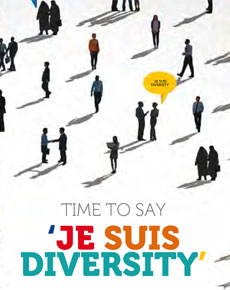Time to say 'Je Suis Diversity'

A thought piece by AUT Professor of Diversity Edwino Pio, first published in EFMD GlobalFocus Volume 09, Issue 03|2015
Global migration has introduced us to new communities and new religious practises. Edwina Pio asks how we can best reconcile them.
How we handle the challenges of today will determine the future of our fragile planet and our humanity. Immigration is changing the composition and texture of workforces both nationally and globally.
The world contains over 5,000 ethno-cultural groups. Technology, cheap airfares and the global economy have scattered people in countless combinations around the planet and in organisations.
We need to move away from solitary identities that stereotype and put people and organisations into boxes. An individual may be a mother, sister, daughter, corporate lawyer, a Muslim, from Afghanistan and a New Zealand national.
Our corporate organisations need to ask some urgent questions: What if our actions were imbued with the sacred? What if activism in organisations evokes better local society and responsible global community? What if sacred activism signals the performance of a deeper understanding and mindful actions for organisations?
We need to understand were the sweet spot is in organisations as we scrutinise gateways of opportunity and pathways to success and influence. And yet organisations are reflections of the environment and so we have to look outside organisations to understand what is happening inside them.
Re-storying our relatedness may mean replacing a master narrative with multiple narratives, each of them true in a particular context and within a given set of circumstances, dependent on religion, geography, culture, migration history and economic prowess. In a planet which is so diverse perhaps the mantra that needs chanting is Je suis diversity.
Diversity is always politically charged and is a complex weave of historical and socio-economic legacies. These weaves affect the practices of organisational and societal life.
There are many approaches to viewing diversity, including ones that primarily focus on the negatives of diversity.
This approach focuses on what makes individuals push towards optimal functioning within the context of five diversity megatrends within which religion is embedded.
Demographic patterns
Increasing global mobility and growth of "non- traditional” migrants in Western countries. Worldwide in 2013, international migrants were approximately 232 million, accounting for some 3.2% of the world’s population.
Religious growth
Multiple religions diffuse historically religious monopolies and drive religious diversity. In 2014, Christians constituted 31.5%, Muslims 23.2%, Hindus 15.0%, Buddhists 7.1% and Jews 0.2% and in total account for roughly three-quarters of the world’s population.
Corridors of Commerce
BRICS, Asia Pacific and halal areas are billion dollar markets.
Human Rights
Fusion of sacred and secular, accommodation and good faith requiring employers to accept religion and/or ethical observances as long as the practice does not unreasonably interfere with the business, guidelines on religious diversity in the workplace.
Whole self@work
Framing diversity in terms of relationships focuses attention on the nature of people’s encounters with one another. These encounters are embedded in the history of societal relations between diverse groups, including the distribution of power, which shapes social roles, expectations and meanings at various group and individual levels.